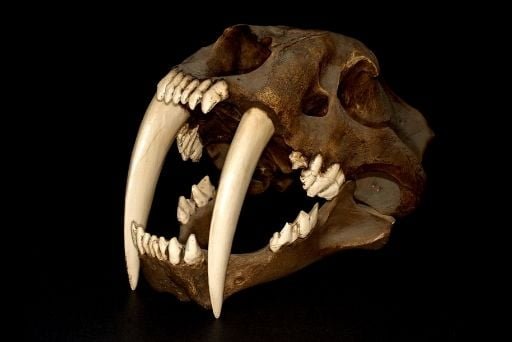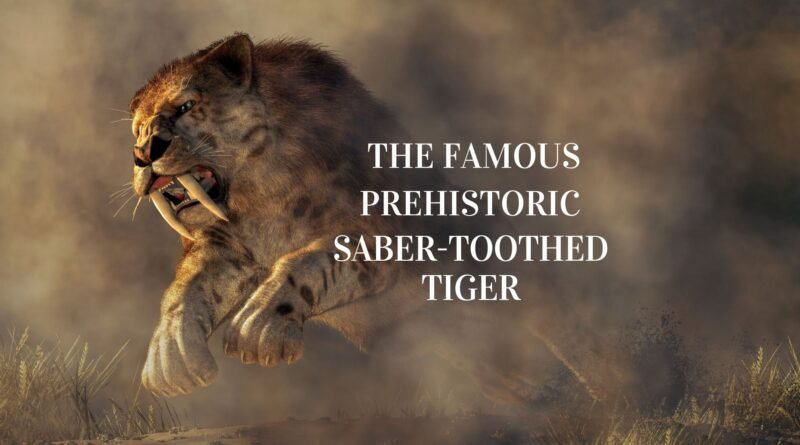The famous prehistoric saber-toothed tiger
Years ago, the earth was a different place altogether. From plants to animal species and even humans looked very different. Modern-day tigers and cats were completely different back then than today. That is what the fossils of the Saber-toothed Tiger suggest to us. These tigers are an extinct cat species that went extinct nearly 10,000 years ago. Although they looked a bit similar to the modern-day tigers, many bodily features contradicted them.
Let us learn more about them as we read!

Appearance
Saber-tooth cats or saber-toothed tigers featured a pair of elongated teeth in their upper jaw. Their teeth were narrow, curved, and had sharp edges to help them prey on their preferred animals easily. Although their teeth looked deadly, they were pretty fragile. Some sources believe that their teeth may have broken if they bit on the bone instead of flesh.
Some scientists also discovered that these cats had short limbs. The cats also had a massive gape that helped them open their mouths as wide as 120 degrees. Such a thing enabled them to make use of their teeth comprehensively. They also had strong abductor muscles and bones, which helped in improved stability and wrestling for prey. These tigers also had a bobtail that enabled them to provide stability and help chase their prey in need. Today its skeletons are also sold at reasonably high prices.
Social behaviour
Most house cats and tigers today are solitary hunters, which naturally makes us feel that their relative, saber-toothed tigers hunted the same way. But it is quite the contrary. Early tigers were exceptionally social, so they often lived and hunted in packs. Many fossil discoveries proved that injuries like fractures and crippling arthritis were prevalent among these tigers.
But if they were alone, they would have died and worsened. However, according to research, there was fast regrowth and improvement in their wounds. It is fair to say that they may have been taken care of by other cats and fed by them as well when they were in grave danger. However, sources also suggest that even if they were social animals, they often fought for female saber-toothed tigers.

Habitat
Saber-toothed tigers seemed to have roamed in North America and Europe. During the Miocene and Pliocene period. This is nearly 26 million years ago. But by the later years, they had spread across other regions like Asia and Africa as well. By the Pleistocene period, some of them were also roaming around in south American areas. But recent research on their fossils is yet to prove if they went on to settle in other locations as well. Generally, they lived for around 20 to 40 years.
Feeding habits
Generally, saber-toothed tigers did not have enough predators of their own. So, it is fair to believe that they were on top of the food chain in those times. Sources suggest that they also had a hunting technique of their own. Its skull was changed to accommodate solid neck muscles’ attachment that helped it bring its head down. They also didn’t have enough lower canines, and upper canines were powerful to prey on animals. They were generally carnivore animals and hunted large herbivore animals as well. Bison, Horses, young mammoths, and mastodons were their daily prey. These tigers also fed on camels and ground sloths. In many cases, these tigers also scavenged on caribou, elks, tapirs, and prong oxen that helped them indulge in delicious feastings.

Extinction
Most people thought that the saber-toothed tigers might have gone extinct due to lack of prey or due to being preyed. But none of that is true. Research suggests that even when they were close to extinction, they had enough to eat. But around 12,000 years ago, something weird happened that led to their death. So, what is it?
“The famous theory for the megafaunal extinction is that either the modifying climate at the end of the final ice age or human activity, or some combination of the two, died off most of the massive mammals,” stated a famous researcher from Vanderbilt University in Nashville. “In the case of these big cats, we expect that it would have been challenging for them to find prey, especially if humans were their competition. We know that when food becomes rare, carnivores like these massive cats tend to consume more of the carcasses they kill. If they spent more time chewing on bones, it should cause detectable changes in the wear patterns on their teeth.”
The bottom line
Although much is unknown about the saber-toothed tigers and their reproduction, we know that they may have bred during the spring season. During those times, the female may have given birth to around three cubs. Although we did not know much about those cubs, for some reason, researchers believe that they may have been born blind.




